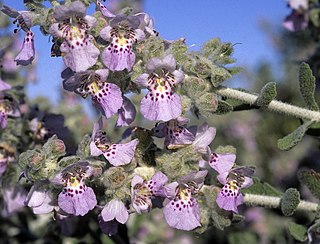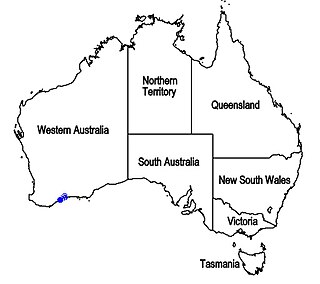Eremophila eriocalyx, commonly known as desert pride, is a flowering plant in the figwort family, Scrophulariaceae and is endemic to Western Australia. It is an erect shrub with greyish leaves, very hairy sepals and petals that range in colour from white to yellow, sometimes pink or purple.

Eremophila weldii is a flowering plant in the figwort family, Scrophulariaceae and is endemic to Australia. It is a shrub with glabrous green leaves, small sepals and purple or lilac-coloured petals and it occurs in arid and semi-arid areas of Western Australia and South Australia.

Hemiphora is a genus of five species of flowering plants in the mint family, Lamiaceae and is endemic to Western Australia. Plants in this genus are woolly shrubs with warty, hairy leaves and with five petals joined to form a tube-shaped flower with four stamens. These species are similar to those in the genus Chloanthes in that the base of the leaves extends down the stem. They differ from Chloanthes, in that the leaves only extend a short distance down the stem.

Eremophila drummondii, commonly known as Drummond's eremophila, is a flowering plant in the figwort family, Scrophulariaceae and is endemic to the south-west of Western Australia. It is a variable shrub, usually with sticky branches and leaves, long, thin leaves and mauve or purple flowers in spring.

Eremophila psilocalyx is a flowering plant in the figwort family, Scrophulariaceae and is endemic to Western Australia. It is an erect shrub with a broom-like shape, narrow, hooked leaves and white, pink, blue or purple flowers. It is common in the mallee country around Esperance. It was sometimes incorrectly known as Eremophila pachyphylla.
Verticordia minutiflora is a flowering plant in the myrtle family, Myrtaceae and is endemic to the south-west of Western Australia. It is a bushy shrub with small, crowded, cylindrical leaves and groups of white to pale pink flowers in summer and autumn. As suggested by its botanical name, it has the smallest flowers of any verticordia.

Quoya atriplicina, commonly known as saltbush foxglove, is a flowering plant in the mint family Lamiaceae and is endemic to Western Australia. It is a bushy shrub with its branches and leaves densely covered with a layer of hairs, giving them a greyish appearance. The leaves are broad-elliptic to almost circular in shape and the tube-shaped flowers are pink with purple spots inside.

Quoya oldfieldii, commonly known as Oldfield's foxglove, is a flowering plant in the mint family Lamiaceae and is endemic to the south-west of Western Australia. It is an erect shrub with its branches and leaves densely covered with a layer of brownish hairs. The leaves are egg-shaped and the tube-shaped flowers are pink with purple spots inside.

Pityrodia loricata is a flowering plant in the mint family Lamiaceae and is endemic to Australia. It is a dense, greyish, multi-stemmed shrub with whorled leaves, prominent sepals and pale, pinkish-white flowers. It is common in Western Australia and the Northern Territory and there is a single record from South Australia.

Pityrodia lepidota is a flowering plant in the mint family Lamiaceae and is endemic to the south-west of Western Australia. It is a small, densely-branched shrub with small leaves and whitish, bell-shaped flowers. The entire plant, apart from the petals, is densely covered with small, circular scales.

Hemiphora elderi, commonly known as red velvet, is a flowering plant in the mint family Lamiaceae and is endemic to the south-west of Western Australia. It is a small shrub with its leaves densely covered with white, woolly hairs and with small clusters of reddish-purple, bell-shaped flowers.

Quoya dilatata is a flowering plant in the mint family Lamiaceae and is endemic to Western Australia. It is a low, spreading shrub with its branches and leaves densely covered with a layer of white, woolly hairs. The leaves are wrinkled or crinkly and the tube-shaped flowers are orange-red and hairy on the outside.

Hemiphora exserta is a flowering plant in the mint family Lamiaceae and is endemic to the south-west of Western Australia. It is a sprawling shrub with its branches densely covered with white, woolly hairs. Its leaves are rough and wrinkled and the flowers are deep pink or dark red, curved and tube-shaped with spreading petal lobes on the end.

Quoya loxocarpa is a flowering plant in the mint family Lamiaceae and is endemic to Western Australia and the Northern Territory. It is an open shrub with many spindly tangled branches. The leaves are oblong and woolly when young and the flowers are whitish pink with purple spots inside and are surrounded by woolly sepals.

Pityrodia hemigenioides is a flowering plant in the mint family Lamiaceae and is endemic to the south-west of Western Australia. It is a spreading shrub with densely hairy branches and leaves, and pale white flowers near the ends of the branches.
Quoya paniculata is a flowering plant in the mint family Lamiaceae and is endemic to Western Australia. It is a shrub with its branches and leaves densely covered with a layer of woolly hairs. The flowers are usually arranged in small groups surrounded by woolly hairs and are bell-shaped and deep purple or deep lilac. It is similar to Dasymalla axillaris and D. terminalis but is distinguished from them by its wedge-shaped leaf ends and more northerly distribution.

Quoya verbascina, commonly known as golden bush, is a flowering plant in the mint family Lamiaceae and is endemic to Western Australia. It is an erect shrub with its branches and leaves densely covered with woolly hairs. The leaves are often oblong but very variable in shape and the flowers are pinkish-white with pink spots inside and are surrounded by yellow woolly sepals.

Prostanthera canaliculata is a species of flowering plant in the family Lamiaceae and is endemic to the south-west of Western Australia. It is a small, erect shrub with hairy branchlets, narrow egg-shaped to narrow elliptical leaves and pale blue or pale violet to white flowers with no markings.

Lasiopetalum parvuliflorum is a species of flowering plant in the family Malvaceae and is endemic to the south-west of Western Australia. It is an erect, spreading shrub with hairy stems, oblong to linear leaves and green or cream-coloured flowers.

Styphelia breviflora is a species of flowering plant in the heath family Ericaceae and is endemic to the south-west of Western Australia. It is an erect, spindly, glabrous shrub that typically grows to a height of up to about 1.5 m. It has oblong to lance-shaped or linear leaves 4–9 mm (0.16–0.35 in) long on a short petiole and with a small, rigid point on the tip. The flowers are borne singly or in pairs in leaf axils on a short peduncle with small bracts and bracteoles about half as long as the sepals. The sepals are about 2 mm (0.079 in) long and the petals white and about 4 mm (0.16 in) long, the petal lobes longer than the petal tube.


















